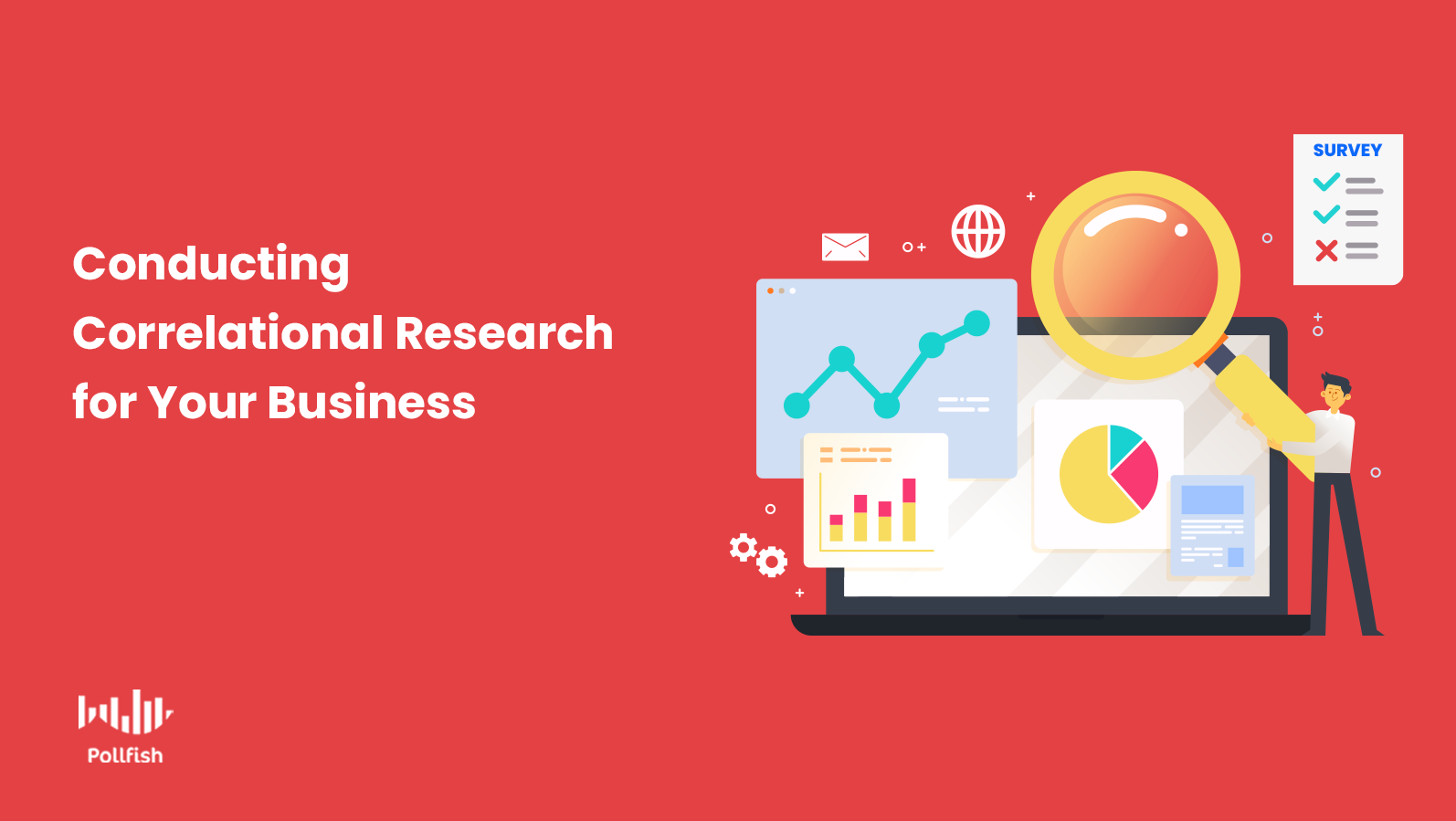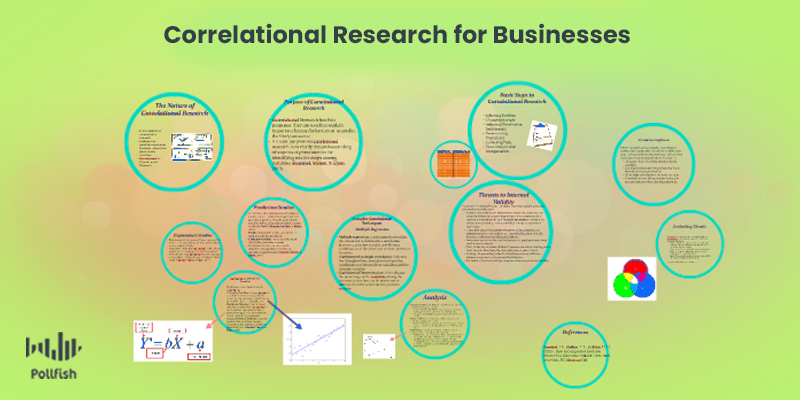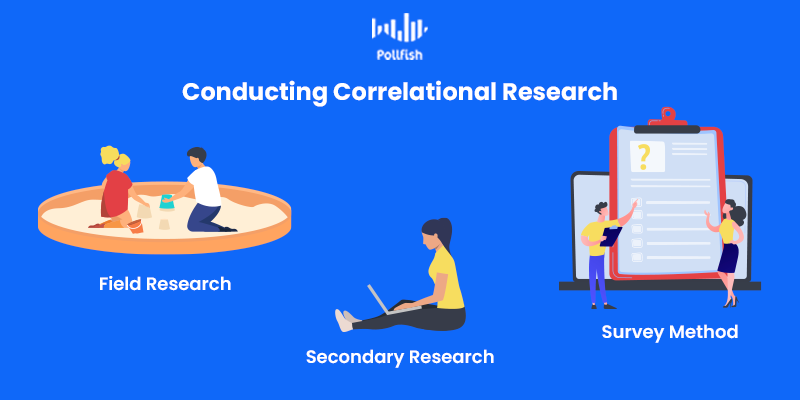What is Correlational Research and How Do You Conduct it for Business Success

Correlational research is a critical form of research that researchers ought to deploy in the mid-late stages of the entire research process. It is especially necessary if it concerns a new topic.
Sequentially following descriptive research, which follows exploratory research, correlational research studies the relationship between two variables. This is important when attempting to make sense out of the variables discovered from exploratory and descriptive research.
Although correlation does not equal causation, understanding the correlation between two variables is crucial to see how similar such relationships may occur and how they behave within an existing occurrence, problem or phenomenon.
This article explains correlational research in-depth, including why it is important to conduct for business research, how to conduct it and more.
Defining Correlational Research
One of the chief forms of research, correlational research depicts and explains the relationship between two variables. This form of research is non-experimental, thus the researcher exerts little to no efforts to control or manipulate the variables.
The variables studied in this kind of research can be either quantitative or categorical.
Correlational research aims to find unknown or suspected relationships between variables, as this can point to similar behaviors or occurrences in other variables. If not, this kind of research is still powerful, as it paints a clearer picture of an issue or phenomenon that had been discovered in exploratory or descriptive research.
In correlational research, researchers measure the relationship between two variables, without controlling either one. The point of this kind of study is to discover:
- Positive correlation: Occurs when variables exhibit changes in the same way. Ex: As purchases increase, store traffic increases.
- Negative correlation: Describes variables that change in contrasting ways. Ex: Increase in employee burnout and a decrease in production.
- Zero correlation: When there is no relationship between the variables. Ex: Seeing employees in the office does not increase signed contracts with B2B partners.
The Key Aspects of Correlational Research
This form of research has several defining characteristics that researchers ought to consider. These aspects help identify this form of research, helping them use it for the future or to contrast it with causal or experimental research.
The following enumerates the key features of this research:
- As nonexperimental research, researchers do not need to manipulate variables to either agree or disagree with a hypothesis.
- It involves measuring and observing the relationship between the variables, with no external conditioning or alterations of any kind.
- It incorporates retrospective elements, as it looks back at past events and data of the variables, as a means to find and calculate historical patterns between them.
- It is conducted when there is some prior knowledge present from either exploratory or descriptive research so that at least one of the factors will relate to the predicted outcome.
- Although it may show a certain kind of correlation between variables, e.g. a positive one, it may not remain as such, as it can change in the future.
- Variables can be observed in a closed environment or via field research, i.e., a public space.
- It is used when the variables are too complex to be studied via the experimental method and controlled manipulation.
- It simultaneously measures variables and their relationships in realistic settings.
- It is executed when a relationship is suspected to be causal, but the researcher can’t manipulate the independent variable due to difficulty, impossibility or legal constraints.
- It is applied when one or a set of objectives requires gathering some degree of prediction.
Why Your Business Needs Correlational Research
Businesses benefit from conducting correlational research in a number of ways. Firstly, this research zeros in on previously murky or uncovered aspects from the entire research process, that of relationships between variables.
This research can confirm or refute these relationships, the hypothesis of their existence, along with the hypothesis of how they relate to the subject matter at large.
Secondly, when a business forms a clear understanding of the relationships between certain variables — whether they are good, bad or nonexistent, it is effectively equipped with the knowledge on how to move forward. For example, a correlational study may require further correlational research, causal research or experimental research.

Or, it may require fewer studies while presenting actionable insights on how to proceed with the studied variables and their environments.
Moreover, it helps researchers understand their studied variables in relation to the past, as it compares present behaviors and other attributes of the variables with retrospective ones. Piggybacking off of this concept, correlational research also helps businesses form predictions.
These predictions pertain to other similar variables, or the same variables and can have a bearing on the near and later futures. Correlational predictions are particularly useful for detecting patterns.
Example of Correlational Research for Business
While there are many different verticals in the sciences and scientific offshoots (ex: psychology, medicine) that appear to require this research, it may not often be so clear as to how it can help businesses.
However, as expounded on above, correlational research is crucial for business and market research. Here is an example of how a business used correlational research in their overall research campaign:
A business noticed the reduction of sales when conducting exploratory research. They noticed that in correlational research, there were particular items that were especially plunging in sales.
Thus, they performed correlational research and discovered that there are two variables that may have a correlation: the rise in kitchen appliances and the decrease in sales of those appliances.
Accordingly, the business deployed surveys to their target market and loyal customers to understand whether in fact, there was a negative correlation present. The surveys proved that this was indeed the case. With this knowledge in tow, the business offered a discount on the appliances, also having considered lowering the prices after some time.
Correlational Research Survey Examples
- The qualitative survey
- Helps understand variables in greater depth.
- Can explain variable behaviors in relation to their environment/context.
- The retrospective survey
- Delves into past events, occurrences and attitudes in regards to the variables.
- Shows whether the variables changed and how so.
- The prospective survey
- Can find associations between variables over a period of time.
- Useful for studying variables to form predictions and understand outcomes.
- The customer loyalty survey
- Great for comparing loyal customers against those who don’t buy from you but are in your target market.
- Measures the variable of continuous purchases.
- The employee satisfaction survey
- Measures relationships between employee satisfaction and workplace or company policy occurrences.
- Helps compare happy and dissatisfied employees.
How Correlational Research Differs from Causal, Exploratory and Experimental Research
Correlational research differs significantly from the other main types of research methods such as exploratory, descriptive and experimental research.
However, causal research is often conflated with causal research. While both kinds of research concern studying the relationships between variables and are conducted in the mid-late stages of research, they study very different aspects. As such, they follow different approaches and measure different things.
Whereas correlational research simply aims to understand how two variables relate to one another, causal research attempts to find a cause and effect relationship between two variables. This research type is more involved in making comparisons.
Exploratory research stands in complete contrast with correlational research, as it provides the very basis of a research problem and forms a hypothesis for later research, without involving variables.
Descriptive research delves into describing something already established, discovered or suspected in exploratory research. Therefore, it is composed after exploratory research in the overall process. It is still an early part of the entire research process.
Unlike correlational research, it attempts to describe what exploratory research had already established in greater detail, with new aspects emerging. It is not concerned with examining variables.
Experimental research contrasts with correlational research, in that it involves manipulating and controlling variables, whereas correlational research exerts absolutely no control or alterations to the studied variables.
As its name suggests, experimental research forms experiments on the variables as a means to discover cause-and-effect relationships. Using a scientific research design, this research involves a controlled environment, one in which the variables can be measured, calculated and then compared.
The Advantages and Disadvantages of Correlational Research
Correlational research offers several benefits for researchers and businesses. However, as with all other research methods, there are a few setbacks to this type of research.
The Advantages
- Allows researchers to determine the statistical relationship between two variables.
- An inexpensive and effective (not time-consuming) research method.
- Grants the research to understand a variable unaltered, existing in its natural state to fully understand it.
- Variables in their natural state are more applicable to everyday situations.
- Although it can’t prove causation, a large amount of collected and analyzed correlational data can support a causal hypothesis.
- Enables researchers to understand the duration and strength of the relationship.
- Using the correlation coefficient to measure a relationship’s strength (ranging from 1.00 to -1.00), the results are easy to classify.
- Provides the most ideal transition to conducting causal or experimental research.
- Provides insight into the way variables operate and exist with each other that other methods cannot find.
- Can occur through quick research such as via surveys or observations.
The Disadvantages
- It is limited, as it can only glean the statistical information from no more than two variables.
- Does not take cause and effect relationships into account, as it doesn’t find which of the 2 variables creates the statistical pattern.
- Does not show which variable wields the most influence.
- Cannot be fully depended on for further research, as it employs past statistical patterns to determine the relationship.
How to Conduct Correlational Research
A comparatively simple and quick way to conduct research, correlational research can be conducted using field research, i.e., via natural observations, through surveys and via secondary research. Here is how to execute this research using all of these techniques.

- Surveys: Allow researchers to get quick and easy to garner feedback (via an online survey platform).
- Ask questions about the variables. Use both open-ended and close-ended questions. The former is better for understanding the variables at a greater depth.
- Then, statistically analyze the answers.
- Field Research: Observe the variables in their natural environment.
- Study customers and passersby in physical shops, use a session replay tool in online shops.
- Record behaviors as they relate to the variables.
- Conduct secondary research: Find all the applicable literature and sources made available.
- These depend on your vertical and subject of study.
- Put them together and compare them to your own findings.
Mastering Correlational Research
Correlational research, although in the mid-stages of research, forms the very onset of relationship research into variables. Like descriptive research, correlational research describes variables, going a step further, as it tracks how one relates with the other.
It is essential to conduct this research to understand the kinds of relationships that exist between two variables before performing any testing on them, whether it’s for comparisons in causal research, or for experimentation in experimental research.
A strong online survey tool makes this possible and practical to carry out. As aforementioned, there are various surveys relevant to use for correlational research. An adept online survey provider will make it feasible to implement all forms in your research, along with sending them to their intended sampling pool.
Pollfish Marketing Team
Ready to Try Pollfish?
Create your survey with AI, target high-quality respondents starting at $0.95 per complete, and start getting results in just minutes in real-time. From running a simple product concept survey to managing a constant stream of trackers for dozens of clients in dozens of countries, we’ve got you.
